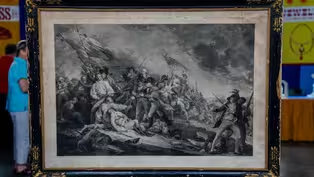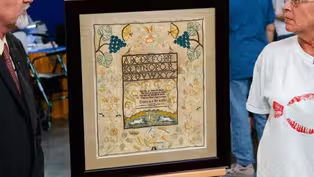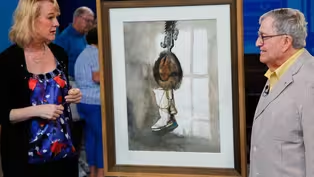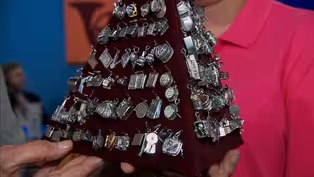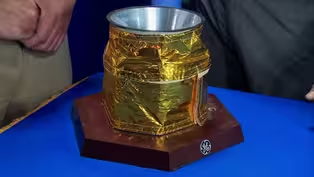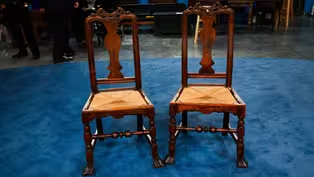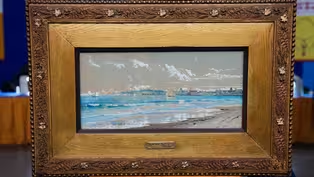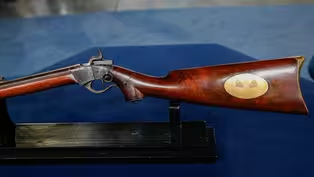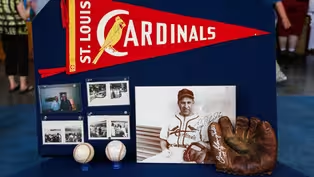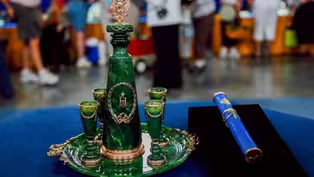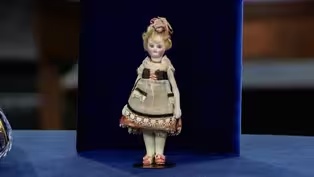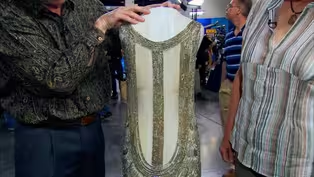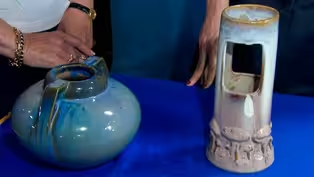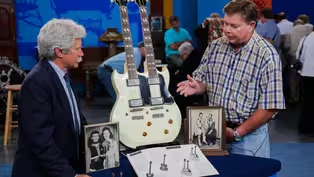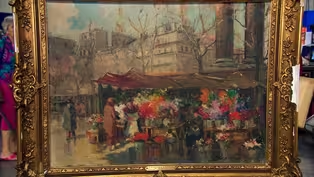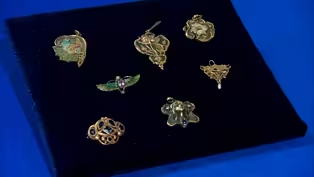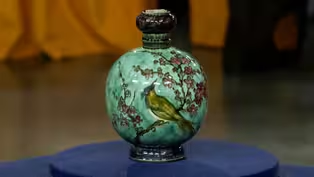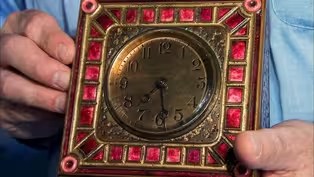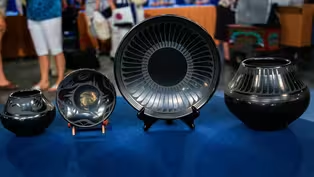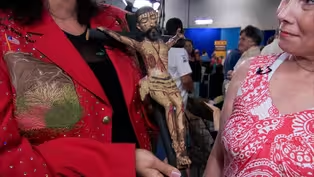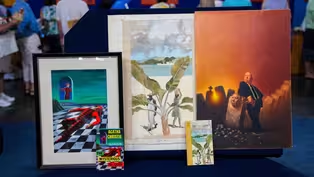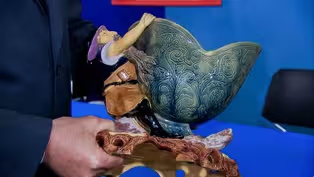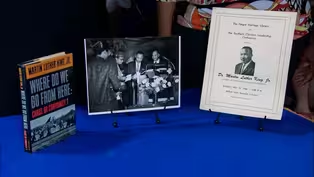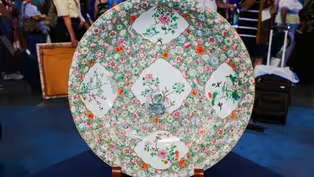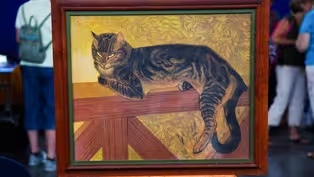
Vintage Raleigh 2025, Hour 2
Season 29 Episode 19 | 52m 24sVideo has Closed Captions
Do values of 2009 ROADSHOW Raleigh finds go up, down or stay the same in today’s market?
Learn if values of 2009 ROADSHOW Raleigh finds go up, down or stay the same in today’s market, including a Gibson Double 12 electric guitar, ca. 1960, an 1812 needlework sampler and a French couture dress, ca. 1925. One triples in value!
Problems playing video? | Closed Captioning Feedback
Problems playing video? | Closed Captioning Feedback
Funding for ANTIQUES ROADSHOW is provided by Ancestry and American Cruise Lines. Additional funding is provided by public television viewers.

Vintage Raleigh 2025, Hour 2
Season 29 Episode 19 | 52m 24sVideo has Closed Captions
Learn if values of 2009 ROADSHOW Raleigh finds go up, down or stay the same in today’s market, including a Gibson Double 12 electric guitar, ca. 1960, an 1812 needlework sampler and a French couture dress, ca. 1925. One triples in value!
Problems playing video? | Closed Captioning Feedback
How to Watch Antiques Roadshow
Antiques Roadshow is available to stream on pbs.org and the free PBS App, available on iPhone, Apple TV, Android TV, Android smartphones, Amazon Fire TV, Amazon Fire Tablet, Roku, Samsung Smart TV, and Vizio.
Buy Now
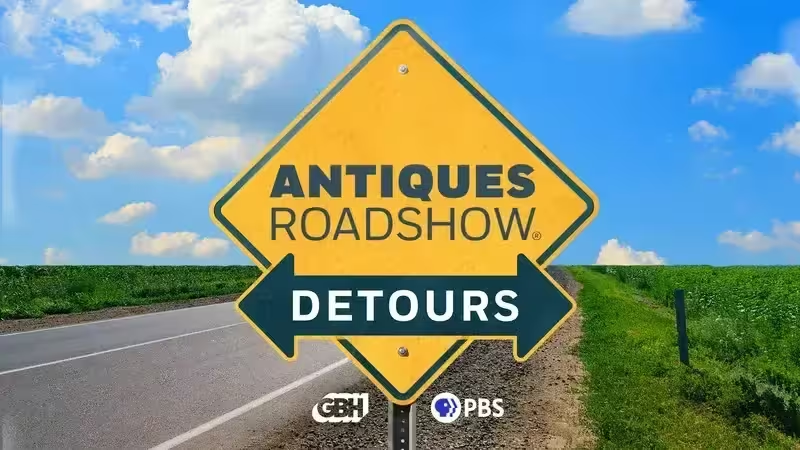
ANTIQUES ROADSHOW DETOURS
Ever wondered what happens to the treasures featured on America’s beloved ANTIQUES ROADSHOW after the cameras leave town? Host Adam Monahan tracks down the juicy afterlives of your favorite finds from PBS’s hit series.Providing Support for PBS.org
Learn Moreabout PBS online sponsorship♪ ♪ GUEST: I'm not a cat lover.
So it's been on my porch for 15 years.
(chuckling): Oh, my gosh!
That's amazing!
Wow!
Is that a real wow?
(laughs) It's a real wow!
♪ ♪ CORAL PEÑA: Raleigh rolled out the welcome mat for "Antiques Roadshow" a sweet 16 years ago.
That's enough time for new kids on the block... ...that was designed to be placed on the moon in the Apollo 11 program.
PEÑA: ...and antique old-timers to see a change in price.
These chairs have all the bells and whistles.
PEÑA: Have the values of these North Carolina discoveries aged well or sagged since 2009?
(laughs): Oh, my gosh!
PEÑA: Learn more in this charming return to Raleigh.
GUEST: I inherited it about 14 years ago from a cousin who had been in the Women's Army Corps during World War II.
And she went to Paris and she bought this painting.
She is a cat lover, and she paid a few hundred dollars for it, and she was told that it was extremely valuable.
And this was in the 1940s?
Yes, mm-hmm.
Okay.
And I'm not a cat lover.
(laughs) So it's been on my porch for 15 years.
And what do you know about it?
I know that he was a contemporary of Toulouse-Lautrec, that he was Swiss and he came to Paris in 1881, and he is more noted for his posters.
The artist's name is Theophile Steinlen.
And you're absolutely right, he was a contemporary and a friend of Toulouse-Lautrec's, also a famous poster artist.
He was born in Switzerland, and, in his early 20s, he moved to Paris.
And he's working in Paris in the 1880s as an illustrator, and soon after that, as a poster artist.
He did a number of images of workers and very much had a social agenda in imaging poorer people, downtrodden people.
But what he's best known for are his posters of Parisian nightclubs and theater programs, and, of course, the beloved cats.
And most of his models are his own cats.
Oh.
So he, he didn't have to go far... I see.
...to find cats to draw.
Mm-hmm.
Now, you said you thought it was a painting initially.
Yeah.
It's actually a color lithograph.
Oh.
So it's a multiple, it's a print.
He made this in an edition of several hundred in 1909.
And it's actually a companion piece to another cat, which is an inside cat, known as the winter cat.
You have the summer cat.
Oh, okay.
He's signed it in pencil right below the cat's front paws.
Up here is his monogram.
And then right here you can see a blind stamp... Oh, yes.
...in the wood.
Oh!
That's the publisher of this print, whose name was Sagot, and it's actually turned on its side.
It's "Sagot, Paris," and he worked with the publisher Sagot throughout his career in Paris to issue these prints.
You have one that's in very, very good condition.
Framewise, it's not good to have a print pushed up to a piece of glass like this.
It would be much better off to have it taken out of this frame and put in a mat so the print itself isn't directly touching the glass.
I see.
What you get here are some humidification marks.
This faint, faint, light mark... Mm-hmm.
...in the wood, that's caused by the print, over time, pressing up to the glass.
Oh.
In this condition, if I had to put a replacement value or a retail value on this... Mm-hmm.
...I would say it's around $10,000 to $12,000.
(exhales) So you're at the top end of the Steinlen cat print market.
I'm stunned.
I'm stunned.
(laughing) (laughing) Do you like cats any more after that?
(both laughing) I'm beginning to love it.
Great.
I just can't believe it-- I can't believe it.
(both laughing) Well, we usually have a fall trip to New England, and a dealer had these chairs, and I had a friend who had died about a year before, and he was giving me, for Christmas, a carved, uh, chair, uh, with the same type of foot.
Oh, right.
And he had called them John Gaines chairs.
Reproductions.
Yes.
Are, are they small?
Big?
They're small, about like that.
Oh, that's so nice.
Mm-hmm.
And may I ask what you... I'm just curious what you, what you paid for them, or... $10,000.
$10,000, okay.
Yes.
So you paid $10,000.
You must've known that they were pretty good, then, I mean... I did know, from looking at pictures, that they were John Gaines chairs... Okay.
...probably, from the foot.
What did you like about 'em the most when you bought 'em?
Definitely the foot!
Definitely the foot, this... And I just fell in love with them.
Okay.
And we were taught by our friend to, you know, look for things like that.
John Gaines and his son worked in Ipswich, Mass., from 17, 0, 07 or so till, like, 1760.
So there was this whole Gaines family that worked in Ipswich and Portsmouth that made these wonderful chairs.
These chairs have all the bells and whistles.
Don't you love this crest rail with this yoke and with this scroll here?
And coming down, a beautiful vasiform splat, and when you look sideways at it, it has the wonderful curve that fits your back.
Here we have the rush seat.
That's replaced, right?
Yes.
You knew that, right?
Yes.
You come down to this double baluster turned stretcher, but the feet, you're right, the feet are so huge.
They're big.
I've never seen larger feet on a John Gaines chair.
When you look at the bottom, they usually have extra pieces of wood laminated to make 'em bigger.
This is actually solid, which you occasionally do see on John Gaines chairs.
So it's wonderful that they have those big, Spanish feet in the Baroque tradition.
This is kind of a Baroque, we also call it William and Mary chair.
This was really high style during the period.
If these had original surface, you'd, they'd be worth a lot more.
You know that these parts are original, but it's harder to tell they're original because all the surface has been cleaned, so you have to look very carefully, because of that, at the parts.
The tool marks, the chips in the plane, are here.
On, there's a, there's a chip right here, a double chip.
And the same double chip, it's like a railroad track pattern, is on the crest rail as on the splat.
So the same tool was used to finish the back as it finished the splat.
So that's a good sign.
You see, little details like that tell us, you know, it's like a clue that it's o, that it's original.
And the same thing on the other chair.
So bottom line is, they're a great pair of chairs, but they've been refinished.
And surface is extremely important on this type of chair.
They're made of maple.
An auction estimate on this pair of chairs would be $30,000 to $50,000, their value as, as they are.
So you didn't do bad.
(laughs): No!
(both laugh) And, and, and that's not bad, right?
And they really are, because they're very rare.
Now, if they had their original surface, they'd be estimated at, probably, $100,000 to $130,000.
But thank you.
Well, I'm very pleased!
Yeah, I, I'm glad you're happy.
Thank you.
GUEST: My grandmother's an antique dealer, and she had it the whole time I was a child.
It sat on our baby grand piano at her house.
Have you any idea where you think it might be from?
I thought maybe Italian, but I'm not sure, I... All right, well, it gives itself away on the bottom here.
There's a little mark impressed.
Mm-hmm.
It stands for Wilhelm Schiller and Son.
They were a Bohemian company... Hm.
...in what is now the Czech Republic.
And this was probably made in about 1885 or so, 1890.
You think so?
Oh!
At auction, it's gonna be estimated at at least $800, or maybe $1,200, yeah.
Oh, my, really?
Oh, yeah.
(mouths): Wow.
It's got a lot going for it.
It's good to know that.
This came down to me through my great-great-great-aunt.
What it represents is New Mexican devotional art.
When the conquistadors landed, they didn't have any place to worship.
So a folk art group started of santeros that created Cristos so these people had devotional art for their homes.
This particular piece, I believe, is made by Rafael Aragón, one of the premier carvers.
On today's auction market, it would fetch somewhere in the $14,000 to $18,000 price range.
Wow.
That's great.
It's really thrilling to be able to stand here today and hold it.
GUEST 2: That's amazing.
GUEST 1: Thank you.
It is a prototype lunar reflector that was designed to be placed on the moon in the Apollo 11 program, which, my father was in charge of lunar cartography for NASA, and this was his pet project.
They placed a series of these ten across, ten deep, on the moon during the Apollo 11 mission, and then shot lasers at it from various points on Earth to measure the distance.
Apollo 11 is really the epicenter of the space program.
And when we landed on the moon, really kind of shot light waves, you know, around the world, so, anything connected to Apollo 11 is, is very interesting.
We look inside, we can see there's a prism in there.
And that would've been part of the reflection process that would've ref, reflected the laser.
It's got the re, reflective foil on it.
As an object, it's pretty innocuous, but it's, it's a wonderful, space-designed piece.
There is precedent for things that were designed and never s, went into space.
I think at auction, we'd be talking something like, conservatively, in the $5,000 to $7,000 range.
Wow!
With, I think, some upside potential.
Right, thank you so much.
Thank you.
GUEST: My husband just received it from his mother, who had inherited it from her great-grandfather, that was married to the niece of the gentleman the gun was given to, who was Thomas Kane.
It's a Sharps pistol rifle, as it's called.
Okay.
It was made in the mid-1850s, and they're pretty scarce.
And there's a couple of interesting features about this gun.
The first thing that struck me, before anything else, was the fact that it was engraved.
Okay.
It's very high-quality engraving, and it's conceivable that it was engraved by one of the most famous engravers of his day, which was, uh, Gustav Young.
Oh, oh.
Who also did a lot of fancy engraving for Samuel Colt.
But even more intriguing, after a little bit more inspection, was the engravings on the patch box here.
What can you tell me about those?
As far as I know, the "Cummings" is the gentleman's name that, during the brink of the war between the Mormon Church, that he was the person that was put in charge at that time.
It says "A.
Cumming."
Okay.
And there's actually a little seal of the, the Utah Territory, and with the date 1850 in Roman numerals, from the creation of the territory.
And there's also the initials "TLK."
Which is Thomas Leaper Kane.
Okay, and also "ADC," which is Alfred Cumming.
Okay.
As you may already know, Thomas Kane was quite famous in Mormon history.
He was a big friend of the Mormons, and responsible for moving them on sort of their westward trek from Illinois.
And Kane was a, a lawyer, but he was also an abolitionist.
Yes.
And the Mormons were also strong abolitionists, so they had mutual interests.
And Kane was actually one of the primary people responsible in having Brigham Young nominated to be the first governor of the Territory of Utah.
The gun was made in the mid-1850s.
Okay.
And all of these things come into play.
The Mormon War... Uh-huh.
...started in May of 1857.
Mm-hmm.
And President James Buchanan at the time was worried that the Mormons were going to essentially rebel... Right.
...from federal authority.
So one of his first acts was to turn the territory over to Mr.
Cumming and replace Brigham Young, and Mr.
Kane was one of those people instrumental in making sure there was a smooth transition.
And the war finally ended in 1858.
But what is even more intriguing about the gun is, over here, there's a plaque... Mm-hmm.
...engraved with Robert Kane giving it to his brother Thomas Kane, and then one month later, Thomas giving it back to his brother, or so it appears.
But it's around a very elaborately engraved seal of the Territory of Utah.
At auction, I think that just the, a Sharps pistol rifle would fetch around $10,000.
Wow.
(laughing) Well, even better, with the Mormon associations... Yes?
...I think at auction, the gun would fetch around $30,000.
(laughing): Oh, my gosh.
That's amazing!
It really is a rare treat, I mean... Wow!
Thank you so much-- that's amazing!
You're... You're welcome.
That really is.
Well, these were offered at a estate auction, uh, about 20 years ago in Fort Smith, Arkansas, from a family that was in the diplomatic corps, and spent time in, uh, Russia.
Mm-hmm.
And supposedly they brought these items back.
And I purchased these.
In terms of how they were portrayed or how they were advertised, can you tell me a little bit about that?
The items were described as items being brought back from, from Russia from the family, but other than that, I just don't recall.
You've brought two very interesting items.
The first item here, this is a drink set.
This is a little more high-end because of the fact that it's carved out of nephrite jade, silver-mounted, gold mountings.
And what's interesting is, on the top is the double-crested imperial eagle.
And on one side is the portrait of Tsar Nicholas and on the other side is the tsarina.
So the piece has very much an imperial flavor to it in terms of style and design.
The second item, this is what is called a wax case.
This would hold a cylinder of wax, and it would be traditionally used when you were sealing an envelope.
You would heat the wax up and it would drip onto an envelope, and then you would impress your family seal to the envelope itself.
Now, we see that there's a series of hallmarks.
There's a Russian hallmark for silver.
There's also the maker mark.
And on this particular item, the base is marked Fabergé.
The drink set also has similar marks.
Do you recall how much you paid for the drink set?
Yeah, I think it was $6,500.
About $6,500.
You know... And for the wax holder?
Probably about $1,000.
Well, they seem to be reasonable prices 20 years ago for these types of items.
Mm-hmm.
If they were Fabergé.
Yeah.
Unfortunately... (chuckles) ...what I do have to tell you is that these are not Fabergé, okay?
Yeah.
These are copies, but these are extremely good copies.
About 20 years ago, when I started in the auction business, a lot of this merchandise was just starting to come into the marketplace.
And even experts in Fabergé were getting fooled by this.
Wow.
Because they were making really good replicas.
I wish they didn't have the fake hallmarks, 'cause if they didn't have the fake hallmarks, then people would look at them as wonderful objects.
Now they look at them as not being real, so they tend to discount them in terms of value.
In today's market, I would say the drink set would bring a value at auction somewhere between $1,500 and $2,000.
The wax holder, probably somewhere between $700 and $900.
I would say for items like this, hold on to them, enjoy them, and, you know, maybe at some point, you'll be able to find a marketplace for them that will help you recoup the money you put into them.
If these were real, at auction, a wax case in this quality would range anywhere between $20,000 and $30,000.
And with the drink set, probably somewhere in the $40,000 to $60,000 range at auction, if these were original Fabergé.
Wow, that's interesting.
(chuckles) Thank you so much for... Thank you for coming to the Roadshow.
GUEST: My grandmother was the caretaker for Anna Bradley.
And when Anna passed, she inherited all her belongings.
And she was looking through a linen box one day, and she found this.
So she unfolded it and then she put it behind glass, tracing back the family ancestry.
They came from England, and then they settled in Delaware.
And I believe it was Maryland and Delaware.
Okay.
So that's, that's a lovely way to acquire an object, isn't it?
Yes.
(chuckles) That may be one reason why we're looking at a needlework which has survived in remarkably good condition.
Needleworks are such that they use vegetable dyes, and as a result, the colors are fugitive.
They're subject to fading, damage from moisture, insect damage.
There are a lot of things that would put them in peril.
Compositionally, it's very beautiful.
This girl, who made this in school, under the guidance of a teacher, had a talent, and I daresay that she probably had a very good teacher, as well.
The inclusion of some of the these wonderful decorative devices-- the butterflies, these grapes and meandering vines with flowers, the rabbits on that sort of grassy knoll all combine to make a compellingly beautiful needlework.
Now, you told me you had it conserved-- I assume that it's acid-free, uh, cardboard next to the piece, the mat and that sort of thing.
Oh, yes.
Which would prevent it f... Museum glass.
Perfect.
That's why this piece is not toned or turned yellow, because it apparently wasn't in a frame backed with wood next to the linen.
The results can be disastrous.
Oh, I'm sure.
This escaped all that, it's terrific.
(both laugh) I'll call it a number nine, so that's pretty good.
Oo!
(laughs) And I think as far as, uh, value is concerned, certainly in an auction situation, I think that it would be estimated probably in the area of, let's say, $20,000 to $30,000.
Wow.
(laughs) That's how good it is.
Wow, that's nice.
This piece of Fulper, which is a little bit later... Mm-hmm.
...than this one, this is probably done in the 1920s.
We call this a Chinese blue flambé glaze.
Fairly typical of middle-period Fulper pieces.
Mm-hmm.
This is a really nice early piece, with elephant's breath flambé glaze.
These, at auction these days, in the $200 area.
This one, probably more like $650 to $950.
Wow!
That's great!
Oh, this is exciting.
My husband is an avid collector, and he was able to get this from a collection in Durham, and it shows when he visited St.
Mark's A.M.E.
Zion Church in Durham... Mm-hmm.
...and he was the president of the Southern Christian Leadership Conference.
And this is from their conference when they were here in Raleigh... Mm-hmm.
...in 1966.
And along with that, he was able to acquire the book from the same collection.
Well, that's what's so fantastic, is that it comes from the period.
Yes.
And it's, uh, direct from 1966, when the visit occurred.
And what I think is r, really terrific about the dust jacket on this book is its pristine condition.
With all modern literature, whether it's a historical book or a piece of fiction, collectors care about the preservation of the dust jacket.
Yes.
And it's just immaculate.
And what makes this even more special is, it was signed.
Yes.
It's been signed on the front free end paper.
And because it was signed at the time of these others, we are very confident that the signature is authentic.
Yes.
In terms of value, the book is going to be worth about $2,000 to $3,000, since it's signed.
Unsigned, they bring the low hundreds.
As an archive, I would give it a premium value, and therefore say that everything together is in the $3,000 to $4,000 range, and that's an auction value.
Wow, my husband is going to be really excited about that.
Oh, terrific.
GUEST: I was doing a general search on an online auction, and I came across a listing for a porcelain teddy bear doll, and when I clicked on it, I expected to see a teddy bear, and I saw this little doll instead.
What did you pay for the doll?
Just over $12.
Wow, that's probably about what it cost to have it sent, right?
(chuckles) It actually cost more to have it shipped.
(laughs) Tell me what you know about the doll.
I believe she's an all-bisque doll, referred to as a mignonette.
And I don't collect a lot of antique dolls, so my knowledge is not broad on it, and, which is why I brought her here today.
The doll is a mignonette, which is a French word for a diminutive or a small doll.
The doll is referred to in the collecting world as a "poupée de poche," the French term for "a doll for your pocket."
And in the 1880s, they were very popular.
There were shops in Paris where the girls could go and they could buy a small doll like this, patterns and clothing and boxes that the doll could fit in.
It's hard to pinpoint the maker, because several makers made similar dolls.
But this is definitely a French one.
What I was amazed to see is the condition of the doll.
The moths have not gotten the hair.
It's clean.
All the clothing is original, and I don't know if you noticed, under the shoes, she has bare feet.
Okay.
Which is a very good feature for an all-bisque or, or mignonette.
It's a five-piece body, which means it's strung at the shoulders and at the hips.
Sometimes, these dolls were jointed at the elbows and, very rarely, also jointed at the knees.
But this little doll has really all the bells and whistles... (chuckles) ...of a, a good French all-bisque.
On today's retail market, I would easily put a price of $3,000 on her.
Oh, my God!
(laughs) (both laughing) I've seen those shoes for $500.
(laughing): For just the shoes?
Just the shoes.
Enos Slaughter and my father-in-law were first cousins.
I was associated with him through our family reunions.
Mm-hmm.
When was this photo taken?
'Cause obviously, this is much later.
(laughs) Yes, this was taken after the family reunion in Roxboro.
We had gone back to Enos's house.
This is in his den at his house.
You and Enos.
Yes.
So what do you remember about Enos Slaughter?
Well, I remember Enos just sitting around talking about baseball.
It was good to sit around and listen to my father-in-law and Enos talk about the old days, as they grew up.
He loved Duke sports.
He coached at Duke, uh, their baseball team, for a few years.
And I just enjoyed sitting around listening to him tell his stories.
He was discovered by Fred Haney, who went on to be manager of the Cardinals, but was writing for "The Durham Morning Herald" back in the early '30s.
Oh, okay.
And that's who got Enos Slaughter a tryout.
And of course, he had a phenomenal careers with the Cardinals for 13 years, he was a member of ten All-Star teams, and then he came to the Yankees in the mid-'50s... Mm-hmm.
...and he went to another three World Series with them.
Great hall-of-famer, elected to the Hall of Fame in '85.
But the defining moment was the '46 World Series, and it seems here, your father-in-law got to go with him, right?
That's, that's correct, they were... Here's Enos in this photo.
That's Enos.
And this is your father-in-law and Enos in this photo, right?
That's correct.
And these photos... Are at Sportsman Park for the World Series in 1946, when they played the Boston Red Sox.
That's right.
Probably the greatest moment in Enos Slaughter's career was game seven, 1946 World Series, bottom of the eighth inning.
Mm-hmm.
The Red Sox had scored two runs in the top, Enos hit a single, they're now two outs with him on first base, and Harry Walker... That's correct.
...hit a double into the gap.
Enos says later on he can see the ball going into the gap, he's gonna go for it, because he wasn't gonna let grass grow under his feet.
(laughs) That's right.
Made what's called "the mad dash for home," and scored under the delayed throw from Johnny Pesky.
That's correct.
Helping to win game seven and putting Red Sox fans into another tailspin for almost 40 years.
(both laugh) This photo, you said, was taken in '46.
That's signed by him, a pennant with his signature on it, and we have a 1951 Cardinals ball in here and a 1959 Yankees ball, which is last year at the Yankees.
Okay.
So I'm gonna go one by one.
We have the photo, that's probably about $150, okay?
The pennant is probably about $200 to $300 signed by him, 'cause he signed a lot in later years.
Mm-hmm.
This baseball, he's not on it... Yeah.
...even though he was on the team, but you have Stan Musial.
That ball will probably be about $200 to $400.
Now, the Yankee ball could go for $1,000.
Oh.
And I'd insure it for at least $1,000, and maybe $1,500.
Oh, okay.
The most interesting piece, though, is this glove.
I got this glove from my brother-in-law.
He had the glove that was given to my father-in-law by Enos after the '46 World Series.
And I had a holster, and he told me he would trade me the holster for the glove, and that's what I did.
Who do you think got the better of the deal?
Uh, I think I did.
(laughs) Well, I think you did, too.
Now, James, the issue here is whether that glove is actually from the '46 World Series.
Yes.
You're not positive.
If we could find documentation or an actual photo match, 'cause this is close, but it's not quite, that glove would be worth quite a bit more than what I'm gonna say it is today.
I would put an insurance value of $1,500 on it.
But if we could ever actually prove that it was from the '46 World Series, his shining moment... Mm-hmm.
...I would say $5,000, $6,000 anyway.
Oh, okay.
If I was gonna insure the entire group, I'd probably do it for about $3,500.
Okay, that's good.
Thank you.
GUEST: When my father died in the 1990s, it came to us.
It's by a Russian artist who worked in Paris called Georgi Lapchine.
For Lapchine, his Parisian pieces of the flower markets are probably among the most desirable.
I would value it at between $20,000 and $40,000.
Not bad.
GUEST: My mom and dad collected these back in the '80s from flea markets.
They all open up and have things inside of 'em or have moving parts.
Dare I say they are charming?
Yeah.
(both laugh) What you have here is a variety of charms that are called articulated.
Okay.
And when you have an articulated charm, it's worth about twice as much as a normal charm.
Okay.
These charms are mostly sterling.
You've got a couple of gold ones.
And from our count, we've got 161 charms on the pyramid... Correct.
...and they go all the way around.
I'm going to show two of my favorite ones.
Okay.
There's a little guy, and I'm not sure if he's an alien, but he, his head bobs.
(laughs) You can see his head bobbing, and he actually closes up into that box.
Mm-hmm.
And then another one, which I particularly like, 'cause I'm a cat person.
Yes.
There's a little cat, and he has the, the lid of the trash can opens up, and there's a fish skeleton in it.
That's one of my favorite, as well.
It's way too cute.
They date from about 1920s through about 1970s.
I consulted with some other appraisers at the table, and we came up with a figure of around $3,200.
(gasps) (laughing): Oh, my gosh!
Isn't that amazing?
I had no idea.
(laughing) For a number of years in the '70s, up until '89, I worked for Dell Publishing in New York City.
And they were getting rid of a lot of the stuff that had been saved for years, actually.
So I ended up with a whole cache of stuff.
And I've had four or five of them framed and hanging in my offices for, for several years, but others have just been lying around in my closet.
And I thought, well, I'll, here's an opportunity with the Roadshow to find out if they have any value.
It's the cover art for the Dell paperbacks.
So we have here the Agatha Christie, "The Mysterious Mr.
Quin," and here's the original artwork for it.
Then you have the "Strong Wind" by Asturias.
And then you have one of the old favorites, Alfred Hitchcock.
Right.
Forgetting the artwork, these old paperbacks are highly collectible now.
And the reason they're highly collectible is, people love the cover art.
Yeah.
They're not tremendously valuable.
You can pick the paperbacks themselves up for anywhere from a few dollars, or sometimes, at flea markets, for less than that, and some go up to ten, 20, 30 dollars.
The Alfred Hitchcock was for his stories?
It... Right, there, every month, there was a different collection of Alfred Hitchcock stories.
And they would have a different cover... A different cover every time, yeah.
Do you know who the artists are on... I, I, I don't, I... This particular one here, this, uh, "Strong Wind," I do, because his art, his name is at the bottom.
I don't for either of the other two.
It would be nice if we knew who the artists were.
If they're known artists that have, have a body of work... Mm-hmm.
...it might boost the price up.
Another thing is, these two, you have the paperback.
The Alfred Hitchcock, you don't have the original paperback.
No.
That would be another search that I'd do, because I don't think it adds tremendously to the value, but it sure is a great selling point.
The "Strong Wind" is probably a little tamer than the others.
It's probably a $500 illustration.
The Alfred Hitchcock, probably in the range of $1,000 to $1,500.
The Agatha Christie, I think, is conservatively a $1,500.
Mm-hmm.
Now, this is all retail.
I'm happy to hear that this is worth $1,000, 'cause I've got 15 of them, so... Wonderful items.
Well, thank you, thank you very much.
My sister and I inherited them when our brother left everything that he had to the both of us.
He did a lot of traveling.
Over the years, he brought back a lot of beautiful Southwestern pottery.
And the little bit I know about it is just from the books that we kept when he passed away and started reading on Maria.
But we knew that was his favorite potterer.
So these are Maria pots?
Yes.
I saw the receipts.
I've got two receipts-- that's all I could find.
And he had paid, like, $110 or something?
$110, $90, $125, something like that.
Okay, there's two signatures on these pots.
Right.
Do you know who the other signature is?
The Popovi is her son.
Right.
Her son didn't live a long time, so they didn't make a lot of pots together.
Mm-hmm.
He was an excellent potter.
All of these pots are dual-signed Maria and Popovi, and he was, Popovi Da was his name.
Da, right.
And I just wanted to turn this over, because you can see, there's the Maria signature, and the Popovi, and the number.
Number.
And I believe this would be fifth month of 1965.
Okay.
I'm pretty sure that it's the date.
The first pot over there, it's a feather design.
Mm-hmm.
And the plate is the same thing.
Right.
These are called an avanyu.
It's a water serpent.
Serpent.
It's almost like a dragon in Japan or China.
Right.
He bought the right pots, and he bought 'em at the right time for the right price.
They're burnished blackware.
She learned to do this in the early '20s, late teens.
It's called reduction firing, and that's what turns 'em black like this.
Condition is a huge thing with Maria pots.
There's a lot of 'em out there.
She made her living doing this.
Doing it, right.
Her whole family did.
Right.
So there's hundreds.
We see no less than a half a dozen a show.
The half a dozen we see are usually worth anywhere from $400 to $1,200, because they've got nicks and scratches and little dents.
Right.
These are really pristine examples of her work.
The feather jar over there, $8,000 to $12,000 in a retail situation, conservatively.
(softly): Okay, right.
The plate, $8,000 to $12,000.
Twelve.
This little avanyu bowl, $4,000 to $6,000, and $4,000 to $6,000 for this.
On that, okay.
So these four pots, which were just sort of Art Deco-style tourist pieces... (laughs) ...from the 1960s... '60s, right.
...are worth $24,000 on the low end, $36,000 on the high end... High end.
...and possibly more.
More, okay.
Uh, it, it's... Again, it's about collectors wanting pristine examples, and you've got 'em.
Right.
I started a job about an hour and a half from my home in Clinton, North Carolina.
It was too far to drive every day, back and forth, so I found an apartment in this nice lady's home, in an upstairs apartment, and when I went in to look, the first thing I saw was this, and I thought, I fell in love with it.
I lived there about three or four years, and when I started to move, she says, "You know that old painting ups..."-- "picture" is what she said-- "...upstairs that you like?
Well, you can take it with you if you promise not to sell it."
Well, I wasn't about to sell it, anyway, so that was an easy agreement.
This is a print by a man named John Trumbull.
And John Trumbull was actually a participant in the American Revolution.
This is a print of the Battle of Bunker Hill.
He wasn't actually at Bunker Hill.
He was in Boston at the time, but he knew these men.
These were colleagues of his.
A lot of these images are based on firsthand drawings he did of the people who were participants.
The British had long had a history of making historical prints of triumphs of the British Army or Navy or whatever, and John Trumbull, who was very proud to be American, decided he wanted to do a similar thing of American historical prints.
And shortly after the revolution, he was going to produce a couple of prints showing these great events in the American Revolution.
And he did the death of Montgomery, and then he did the Battle of Bunker Hill.
And he did paintings of them which were intended to be made into prints.
Now, he didn't feel at that time-- this is the end of the 18th century-- that there were American engravers who were able to do the quality that he wanted.
It's a, quite a large print.
So he went over to Europe-- to London, interestingly, even though they were the ones who lost the war... (chuckles) ...and he had an engraver over there named Müller do the engraving of this.
And you can see up here, in little stippled dots, is the name of the engraver, and 1794, which is when the engraving was made.
Now, it took a little while for them to get the plate done, to get it published, so it wasn't actually published until 1798, and it was done by a man named de Poggi in London.
And you can see down here is the name of the publisher and the date, and John Trumbull's name is down here.
So we're talking about an 18th-century engraving of an 18th-century battle by a man who was in the vicinity, was in the war.
So it's as authentic as you get.
Now, obviously, one of your concerns is condition.
Absolutely.
You have quite a bit of foxing spots here.
You have some water damage on the far margin over there, and then you have some area where it's actually worn.
This line along here is called the plate mark.
That's where the copper plate pressed into the paper, and it's, so it's thinner there.
And you can see over here, it's actually broken through.
Now, the paper on this is very good.
It's 18th-century paper.
So the paper itself is good.
Bad things have been done to it.
If it's treated well by a professional, you can make it look almost like new.
And with prints, unlike furniture, which aren't necessarily going to die if you don't fix them, a print, this will die.
It will crumble.
It will get worse and worse.
So it is very important that you fix it up.
But even in this condition, I would insure this for about $5,000.
(chuckling): So a fairly substantial amount, even in this condition.
(chuckling): Yes.
It would probably cost you, I would think, $500 or $600 to, to fix it up if you were going to restore it with a professional.
But that would probably add about $1,500 on to the value of the print, so it's well worth doing it.
Thank you.
That's wonderful.
APPRAISER: You only have two pieces here that are really of the period that are plique-à-jour, Art Nouveau.
All the others are copies made in the '60s.
This one is of the period.
This one, it's around 1900 and it's by a very, very good maker, Durand and Company out of Newark, New Jersey.
This is around $800, the highest value of all these pieces.
Wow.
Was that the most expensive one that you bought?
(chuckles) No, actually, that was one of the cheaper ones.
(laughs) Well, I got it from my grandfather.
It says "Tiffany" on the front.
Okay.
That's all I know.
It's an enameled clock.
So we have this beautiful face.
It says "Tiffany & Company" here.
A beautiful piece.
Of course, Tiffany items are in very high demand.
For a retail price... Uh-huh.
$7,500.
Wow.
Really?
So that's nice.
Wow, that's great.
It belonged to my great-aunt.
She got it in Paris in about the 1920s, we believe.
You're exactly right on the period, it's 1920s.
Probably about mid-'20s, because it has a little bit of a flare.
The earlier '20s was straighter.
These are very collectible, and if you were to go to a good auction, you would expect to pay around $2,000 for this dress as it is.
This woman was a little on the wild side, a little on the racy side.
(stammers) That's very interesting.
I've acquired this piece, uh, from my mother.
Okay.
It was, uh, handed down to me from her after she had passed away.
Do you know where it's from or how old it is?
Actually, I do not.
Okay.
Uh, history, uh, goes back to my mom's third cousin, and her husband had purchased it in the Far East I believe in the mid-'50s.
Okay.
So in a way, I've actually stared at this bowl ever since I was... A young man.
...about four years old.
I believe it was on a fireplace mantel.
It's a very impressive porcelain charger.
It's Chinese.
This decoration on the ground is millefleur, which describes this heavy profusion of foliate sprigs on a scrolling ground.
And it's on a gold gilt background.
Additionally, these famille verte or famille rose Chinese porcelain chargers have wonderful cartouches.
In this instance, we see blackbirds with lotus sprigs.
The central cartouche shows highly and well-enameled phoenix over a rockwork base.
We have bamboo.
Overall, it's a highly and well-enameled charger.
On the back, it has a Qianlong mark.
Yes, I saw that mark.
Right.
And I was wondering, was it Ming Dynasty or something of that nature?
Right, it's not a, a Ming mark.
It's a Qianlong mark.
Qianlong?
Qianlong, who was an emperor that reigned in the 18th century that... 18th century?
Eighteenth.
Items from the Qianlong period are highly sought-after.
Oh, huh.
It's arguably the period of the best Chinese porcelains, the best Chinese bronzes, and the best decorative arts.
So the Qianlong mark is there.
However, it's not an 18th-century piece.
It's a late 19th-, early 20th-c, century piece.
Is it a reproduction?
Is that what you're saying?
It's, it's not a reproduction.
It, the, the Qianlong mark is out of reverence... I see.
...and respect... I understand, I see.
...for the, for the very high quality of... Interesting.
...of artisan work during the 18th century.
Do you have an idea of value?
I believe when my, uh, mother was alive, she said, I think in 1989, 1990, it was in the $1,300 to $1,700 category, so... $1,300, okay.
That may have been a fair price then.
The Chinese are buying well-enameled porcelains and high-quality decorative arts with more vigor than ever before.
Oh.
There's a booming middle class in China, and they wish to consume good-quality decorative arts.
Those that cannot afford 18th-century and imperial pieces are buying good 19th-century famille verte and famille rose porcelain works of art.
I would place a, a auction estimate of $8,000 to $12,000.
You said how much?
At auction, between $8,000 and $12,000.
At $8,000 to $12,000 in an auction, wow.
So it... And if it were from the 18th century?
(laughing) Uh... It's, it's, uh... Six figures.
(chuckling) It's a lot of money.
Yeah, I can imagine.
It's a, it's a huge sum of money.
This was my mother's guitar, and, uh, it was manufactured sometime between 1959 and 1962.
Basically it was a pre-production model of the double-necks that were produced in the '70s.
Tell me about your mother and, and her bands.
Well, my mother was Dixie Lee of the Rhythm Ramblers in the 1940s and '50s, and this is my father and my mother and my oldest brother.
And they were affiliated with a lot of the early bluegrass and country-western stars in the Virginia area.
Mm-hmm.
Did you ever see her play both necks?
Not her at the same time, but she would play the guitar sitting down and my old, brother, as he got older, would lean over her shoulder and they would play.
This middle toggle switch will allow both necks to be live at the same time, so my brother and my mother would play the guitar at the same time.
My mother had a Kay guitar that was her favorite, had, she'd owned for many years.
And after a show one night, it's my understanding that, uh, the guitar did not get loaded into the car correctly, and they actually backed over it and destroyed her Kay guitar.
Oh, no!
Okay.
And so my father special-ordered this guitar as a replacement to her favorite guitar.
What possessed him to order a double-neck?
Probably guilt for running over her guitar.
(chuckles) And this was probably the most expensive guitar that Gibson made.
I would have thought.
Well, you already know it's a very rare model.
Right.
It's a Gibson Model Double 12, six- and 12-string neck guitar, made by the Gibson Guitar Company in Kalamazoo, Michigan.
And in fact, you have a catalogue here.
And in the catalogue, it shows the guitar a little differently.
It shows it without this center pick guard right here.
At the time, the guitar cost $600 and the case cost $90.
But, like you said, they made very few of them, and this is... You mentioned a pre-production model.
Why did you say that?
Well, this was actually sort of a prototype that Gibson was doing, and I don't think any of the 46 guitars that, that were made were exactly the same, but each guitar could be customized for the person.
Also, according to the catalogue, they made three different color finishes.
They made black, sunburst, and white.
I've only ever seen 'em in white before.
I see it has a couple of replacements.
It has... Two of the knobs are replaced, and I see that switch is replaced.
Correct.
I see that the tuners are replaced.
And here's the original tuners here.
The knobs deteriorate over the years.
Right.
The case... (laughing): That's an amazing thing.
(chuckles) It's got the original brown case with the pink lining.
And I think, if you didn't have the case, it'd be awfully hard to get another one.
Right.
You had somebody appraise it at one time.
I had it appraised on the internet just from a picture.
When was that?
Just for insurance purposes.
1999.
And how much did they say it was worth then?
They appraised it at $12,000.
Well, electric guitar values have fluctuated quite a lot.
Even four years ago, most electric guitars had doubled in value from where they'd been a couple of years prior to that.
Some of them had tripled.
And all of a sudden, before the economic crisis hit, they just took a dive.
Sure.
This kind of guitar is outside of the realm of common collector electric guitars.
Right.
It's so scarce that I think if you were a collector that didn't have one, you might pay, retail, somewhere between $25,000 and $35,000 for it.
Wow.
GUEST: I have a number of Andrew Wyeth signed prints, but I've always wanted to have an original painting.
And I started looking in earnest when I'd saved enough money, in 1985, and I had a dealer reach me, and he said that he had this painting, it's called "The Trammel," and he quoted a price to me.
And I said I'd think about it, and I then called another dealer that I knew dealt in Andrew Wyeth to determine if, uh, the value, or what he had offered, was a reasonable price.
And the other dealer said, "Why, that so-and-so!"
(chuckling) He said, "He doesn't own that picture.
I have it hanging in my house."
And he said, "I offered it to him," and he was only going to offer it to a specific client-- which wasn't me-- and so he said, "I wouldn't sell it to him from any, for anything."
He said, "Would you like to buy it?
"I'll give you the same wholesale price I was going to give him."
And I couldn't turn that down.
And what was that wholesale price?
$75,000.
Well, Andrew Wyeth, as you know, is a major figure in the world of American paintings.
He was born in 1917 in Chadds Ford, and he just died this past January in Chadds Ford.
He worked primarily in Pennsylvania and Maine, and he was a Realist all his life, even when everyone else in the art world was going crazy over Abstract Expressionism.
And his first show in 1937 was a sellout.
So he became popular early on in his career.
You can see it is signed "Andrew Wyeth" here in the lower left.
And the work dates from 1985, the same year that you bought it.
What I love about this picture is that it really shows how Andrew Wyeth is a master of watercolor painting, which is not an easy medium in which to work.
You can see here that he's used the unpainted parts of this white paper to incorporate it into the composition as the reflection from the window.
And here you see it as the leather on the boot.
And the other thing I can really appreciate is, when I look at this fur hat, I can really imagine what that must feel like.
He does such a good depiction of different textures, and his love for old objects.
Now, you had a good explanation for what a trammel was.
Well, a trammel, as they explained to me, is sort of a hanger that they put on a fire iron, and, and hang cooking pots on it, so they can cook in the fire.
And he's converted it into, you might call it a hat rack.
Now, there's something else about this picture on the reverse.
I was told that there was a painting on the back of this picture.
And the only thing I had depicting that was a fax black-and-white copy of what it is.
I was immediately tempted to reframe the picture, and the dealer that sold it to me suggested I don't do that, because he said Andrew Wyeth had framed this picture himself.
And so I never have seen the back of it.
Well, I think, as the owner of this work, you are entitled to see the reverse of the painting and see firsthand what that sketch on the back looks like, rather than rely on a bad fax image.
And the fact that Andrew Wyeth framed this is important, but as long as you keep it in the frame after you unframe it, then you will honor his contribution to the framing.
But I think it's absolutely fine if you take it out of the frame so you can see the reverse, and it will not affect the value.
I appreciate that information, and it's a very tempting idea.
People often assume that when an artist dies, his work will automatically go up in value, so I think we're really kind of in a waiting period to see what's really going to happen with his market.
This is a very nice example of his work, and I think you would be fine at insuring the work at $450,000.
Wow!
That is a nice price.
Is that a real wow?
(both laugh) That's a real wow!
And I sh, might throw in, "Are you kidding?"
(laughs) Which is what people oftentimes say.
But it's nice to know that that's what's happened to that painting.
PEÑA: And now it's time for the "Roadshow" Feedback Booth.
This was supposed to pay for our child's education.
And lo and behold, it's an impostor.
Maybe it'll pay for our lunch.
(laughs) And Mom, I'm only going to say this once.
You were right.
(chuckles) I came here by myself with my dates, my girls.
Uh, we had a great time at the Antiques Roadshow, and, as you can see, we're all smiling.
And I brought this sign from the Atlantic Coast rail line.
Uh, it turned out to be $80 to $100, not, not too bad, but at least I get to go home with one treasure today.
(gasps, laughs) And this is my treasure.
It was praised for $100 to $125.
It is actually silver, and it comes from Sweden.
That's a good eight-dollar find.
(laughs) I have a cap here autographed by Joe DiMaggio, Hank Aaron, Enos Slaughter, and my favorite baseball player, Carl Yastrzemski.
And it's worth about $250.
Hey, maybe I can buy a hot dog at Yankee Stadium.
And my father got these on the South Pacific.
He traded bed sheets for 'em, and he called them his fertility gods.
But they're worth about $30, but to him, he got six wonderful daughters out of 'em, so they work!
PEÑA: Thanks for watching.
See you next time on "Antiques Roadshow."
Appraisal: 1798 John Trumbull Engraving
Video has Closed Captions
Clip: S29 Ep19 | 3m 48s | Appraisal: 1798 John Trumbull Engraving (3m 48s)
Appraisal: 1812 Needlework Sampler
Video has Closed Captions
Clip: S29 Ep19 | 2m 7s | Appraisal: 1812 Needlework Sampler (2m 7s)
Appraisal: 1985 Andrew Wyeth "Trammel" Watercolor
Video has Closed Captions
Clip: S29 Ep19 | 4m 38s | Appraisal: 1985 Andrew Wyeth "Trammel" Watercolor (4m 38s)
Appraisal: 20th C. Articulated Silver & Gold Charms
Video has Closed Captions
Clip: S29 Ep19 | 1m 26s | Appraisal: 20th C. Articulated Silver & Gold Charms (1m 26s)
Appraisal: Apollo II Lunar Reflector Model, ca. 1969
Video has Closed Captions
Clip: S29 Ep19 | 1m 23s | Appraisal: Apollo II Lunar Reflector Model, ca. 1969 (1m 23s)
Appraisal: Chairs Attributed to John Gaines III, ca. 1735
Video has Closed Captions
Clip: S29 Ep19 | 3m 40s | Appraisal: Chairs Attributed to John Gaines III, ca. 1735 (3m 40s)
Appraisal: Edmund Darch Lewis Watercolor, ca. 1885
Video has Closed Captions
Clip: S29 Ep19 | 34s | Appraisal: Edmund Darch Lewis Watercolor, ca. 1885 (34s)
Appraisal: Engraved Sharps Pistol Rifle, ca. 1857
Video has Closed Captions
Clip: S29 Ep19 | 3m 16s | Appraisal: Engraved Sharps Pistol Rifle, ca. 1857 (3m 16s)
Appraisal: Enos Slaughter Baseball Group, ca. 1950
Video has Closed Captions
Clip: S29 Ep19 | 3m 47s | Appraisal: Enos Slaughter Baseball Group, ca. 1950 (3m 47s)
Appraisal: Fake Fabergé Set & Wax Case, ca. 1980
Video has Closed Captions
Clip: S29 Ep19 | 3m 22s | Appraisal: Fake Fabergé Set & Wax Case, ca. 1980 (3m 22s)
Appraisal: French Bisque Mignonette Doll, ca. 1880
Video has Closed Captions
Clip: S29 Ep19 | 2m 15s | Appraisal: French Bisque Mignonette Doll, ca. 1880 (2m 15s)
Appraisal: French Couture Dress, ca. 1925
Video has Closed Captions
Clip: S29 Ep19 | 41s | Appraisal: French Couture Dress, ca. 1925 (41s)
Appraisal: Fulper Pottery Vases, ca. 1920
Video has Closed Captions
Clip: S29 Ep19 | 38s | Appraisal: Fulper Pottery Vases, ca. 1920 (38s)
Appraisal: Gibson Double 12 Electric Guitar, ca. 1960
Video has Closed Captions
Clip: S29 Ep19 | 3m 17s | Appraisal: Gibson Double 12 Electric Guitar, ca. 1960 (3m 17s)
Appraisal: G. Lapchine "The Flower Market" Oil, ca. 1935
Video has Closed Captions
Clip: S29 Ep19 | 30s | Appraisal: G. Lapchine "The Flower Market" Oil, ca. 1935 (30s)
Video has Closed Captions
Clip: S29 Ep19 | 41s | Appraisal: Jewelry Collection (41s)
Appraisal: John Bennett Faience Vase, ca. 1885
Video has Closed Captions
Clip: S29 Ep19 | 1m 4s | Appraisal: John Bennett Faience Vase, ca. 1885 (1m 4s)
Appraisal: Louis C. Tiffany Furnaces Clock, ca. 1920
Video has Closed Captions
Clip: S29 Ep19 | 27s | Appraisal: Louis C. Tiffany Furnaces Clock, ca. 1920 (27s)
Appraisal: Maria & Popovi Pottery, ca. 1965
Video has Closed Captions
Clip: S29 Ep19 | 2m 58s | Appraisal: Maria & Popovi Pottery, ca. 1965 (2m 58s)
Appraisal: Mid-19th C. José Rafael Aragón Crucifix
Video has Closed Captions
Clip: S29 Ep19 | 46s | Appraisal: Mid-19th C. José Rafael Aragón Crucifix (46s)
Appraisal: Paperbacks & Original Cover Art, ca. 1950
Video has Closed Captions
Clip: S29 Ep19 | 2m 35s | Appraisal: Paperbacks & Original Cover Art, ca. 1950 (2m 35s)
Appraisal: Wihelm Schiller & Sons Majolica Bowl, ca. 1885
Video has Closed Captions
Clip: S29 Ep19 | 45s | Appraisal: Wihelm Schiller & Sons Majolica Bowl, ca. 1885 (45s)
Appraisal: Martin Luther King Jr. Archive
Video has Closed Captions
Clip: S29 Ep19 | 1m 31s | Appraisal: Martin Luther King Jr. Archive (1m 31s)
Appraisal: Chinese Famille Rose Charger, ca. 1900
Video has Closed Captions
Clip: S29 Ep19 | 3m 20s | Appraisal: Chinese Famille Rose Charger, ca. 1900 (3m 20s)
Appraisal: 1909 Steinlen "Summer: Cat on a Balustrade" Lithograph
Video has Closed Captions
Clip: S29 Ep19 | 3m 21s | Appraisal: 1909 Steinlen "Summer: Cat on a Balustrade" Lithograph (3m 21s)
Providing Support for PBS.org
Learn Moreabout PBS online sponsorship
- Home and How To

Hit the road in a classic car for a tour through Great Britain with two antiques experts.













Support for PBS provided by:
Funding for ANTIQUES ROADSHOW is provided by Ancestry and American Cruise Lines. Additional funding is provided by public television viewers.


